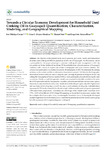Mostrar o rexistro simple do ítem
Towards a Circular Economy Development for Household Used Cooking Oil in Guayaquil: Quantification, Characterization, Modeling, and Geographical Mapping
| dc.contributor.author | Hidalgo, José | |
| dc.contributor.author | Álvarez-Mendoza, César I. | |
| dc.contributor.author | Soto, Manuel | |
| dc.contributor.author | Amaya-Rivas, J. L. | |
| dc.date.accessioned | 2022-10-11T17:52:31Z | |
| dc.date.available | 2022-10-11T17:52:31Z | |
| dc.date.issued | 2022 | |
| dc.identifier.citation | Hidalgo-Crespo, J.; Alvarez-Mendoza, C.I.; Soto, M.; Amaya-Rivas, J.L. Towards a Circular Economy Development for Household Used Cooking Oil in Guayaquil: Quantification, Characterization, Modeling, and Geographical Mapping. Sustainability 2022, 14, 9565. https://doi.org/10.3390/su14159565 | es_ES |
| dc.identifier.issn | 2071-1050 | |
| dc.identifier.uri | http://hdl.handle.net/2183/31798 | |
| dc.description | This article belongs to the Special Issue Applications of GIS and Remote Sensing for Sustainable Development | es_ES |
| dc.description.abstract | [Abstract] The objective of the present study was to quantify, geo-locate, model, and characterize domestic used cooking oil (dUCO) generation for the city of Guayaquil. For this reason, and as a prerequisite for the proper planning of municipal cooking oil waste management in the city, we carried out 14-day fieldwork involving 532 households from different parishes of Guayaquil, combined with a survey to acquire data on their demographic and socioeconomic statistics. The artisanal characterization was further executed to 40 subsamples of dUCO to determine the density, moisture, solids content, and the volatile-matter characteristics present. Additionally, the Geographic Information System (GIS) was used to map the used cooking oil generation hotspots for the city, adding the Geographical Position System (GPS) of each participating household during the data acquisition. Finally, a multiple-regression model was proposed to establish correlations between the dUCO generated and five independent variables, such as household size, socioeconomic group, tenure status, education level, and income. Results showed that the per capita daily dUCO-generation rate was found to be 4.30 g/day/c or 4.99 mL/day/c, with a density of 0.86 g/mL. Filterable solids represented 0.37% for the entire dUCO collected sample, while separable water and grease represented 1.58% and 0.014%, respectively. In addition, the percentage of the volatile matter was found to be 7.7% ± 2.1% of the filtered dUCO. Using GIS mapping, we found that the areas near tourism sites have a higher dUCO generation value, considering the household survey. Following the developed multiple-regression model developed, it was found that household size and the socioeconomic group have the maximum effect on generating used cooking oil. | es_ES |
| dc.language.iso | eng | es_ES |
| dc.publisher | MDPI | es_ES |
| dc.relation.uri | https://doi.org/10.3390/su14159565 | es_ES |
| dc.rights | Atribución 4.0 Internacional (CC BY 4.0) | es_ES |
| dc.rights.uri | https://creativecommons.org/licenses/by/4.0/ | * |
| dc.subject | Used cooking oil | es_ES |
| dc.subject | Household | es_ES |
| dc.subject | Restaurant | es_ES |
| dc.subject | GIS mapping | es_ES |
| dc.subject | Quantification | es_ES |
| dc.subject | Regression | es_ES |
| dc.title | Towards a Circular Economy Development for Household Used Cooking Oil in Guayaquil: Quantification, Characterization, Modeling, and Geographical Mapping | es_ES |
| dc.type | info:eu-repo/semantics/article | es_ES |
| dc.rights.access | info:eu-repo/semantics/openAccess | es_ES |
| UDC.journalTitle | Sustainability | es_ES |
| UDC.volume | 14 | es_ES |
| UDC.issue | 15 | es_ES |
| UDC.startPage | 9565 | es_ES |
| dc.identifier.doi | 10.3390/su14159565 |
Ficheiros no ítem
Este ítem aparece na(s) seguinte(s) colección(s)
-
GI-EnQA-Artigos [16]






